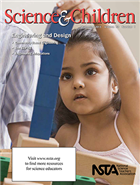The "E" in STEM
By Peggy Ashbrook
Posted on 2015-09-29
 Teaching a “STEM” class or curriculum means addressing each letter in the acronym. In a rigorous STEM curriculum, those four areas of teaching and student learning—Science, Technology, Engineering and Mathematics—will be observable every day.
Teaching a “STEM” class or curriculum means addressing each letter in the acronym. In a rigorous STEM curriculum, those four areas of teaching and student learning—Science, Technology, Engineering and Mathematics—will be observable every day.
Technology
The technology piece may be the easiest to incorporate because the technologies for writing and drawing have been staples in teaching young children for a long time. Children document their observations and thinking with their drawings and writing. Some programs fully integrate newer technologies such as cameras, computers, and easily portable devices for recording and documenting. “Technology and Interactive Media as Tools in Early Childhood Programs Serving Children from Birth through Age 8,” is a joint position statement issued by the National Association for the Education of Young Children (NAEYC) and the Fred Rogers Center for Early Learning and Children’s Media at Saint Vincent College.
Mathematics
Early Childhood Mathematics: Promoting Good Beginnings, the 2010 joint position statement of the National Association for the Education of Young Children (NAEYC) and the National Council of Teachers of Mathematics (NCTM), describes high quality mathematics education.
Science
The National Science Teachers Association’s (NSTA) position statement on Early Childhood Science Education was endorsed by NAEYC in 2014. The principals and declarations clarify how to teach science concepts and topics.
Engineering
Early childhood teachers need professional development to prepare to teach engineering concepts. The American Society for Engineering Education describes professional development that addresses the fundamental nature, content and practices of engineering.
Guides such as STEM Sprouts Teaching Guide by the Boston Children’s Museum and the MA Board of Education’s Guidelines for Preschool Learning Experiences provide direction for intentionally including engineering teaching.
 Learn how preschool teachers in Hartford, Connecticut implemented a unit on the topic of Building Structures (Chalufour and Worth 2004) in mixed-age classrooms of three-, four-, and five-year-old students, in “Gimme an E! Seven strategies for supporting the “E” in young children’s STEM learning” by Cynthia Hoisington and Jeff Winokur. This article in the September 2015 Science and Children describes how instructors and coaches in the professional development program Cultivating Young Scientists facilitated teachers’ preparation of the environment by planning space, materials, and time for building explorations. Hoisington and Winokur emphasize that preschool teachers need opportunities to participate in and reflect on their own collaborative building explorations. So grab a set of blocks, try building a tower and then reflect on how to build a better tower. Write some productive prompts to use when children build structures, to invite them to raise questions, and identify, address, and solve building challenges.
Learn how preschool teachers in Hartford, Connecticut implemented a unit on the topic of Building Structures (Chalufour and Worth 2004) in mixed-age classrooms of three-, four-, and five-year-old students, in “Gimme an E! Seven strategies for supporting the “E” in young children’s STEM learning” by Cynthia Hoisington and Jeff Winokur. This article in the September 2015 Science and Children describes how instructors and coaches in the professional development program Cultivating Young Scientists facilitated teachers’ preparation of the environment by planning space, materials, and time for building explorations. Hoisington and Winokur emphasize that preschool teachers need opportunities to participate in and reflect on their own collaborative building explorations. So grab a set of blocks, try building a tower and then reflect on how to build a better tower. Write some productive prompts to use when children build structures, to invite them to raise questions, and identify, address, and solve building challenges.
Disclaimer: The views expressed in this blog post are those of the author(s) and do not necessarily reflect the official position of the National Science Teaching Association (NSTA).


